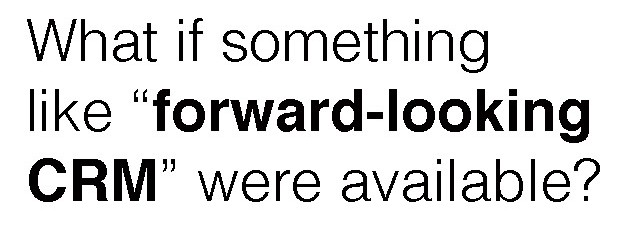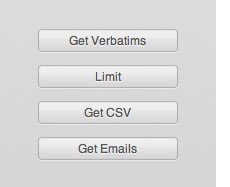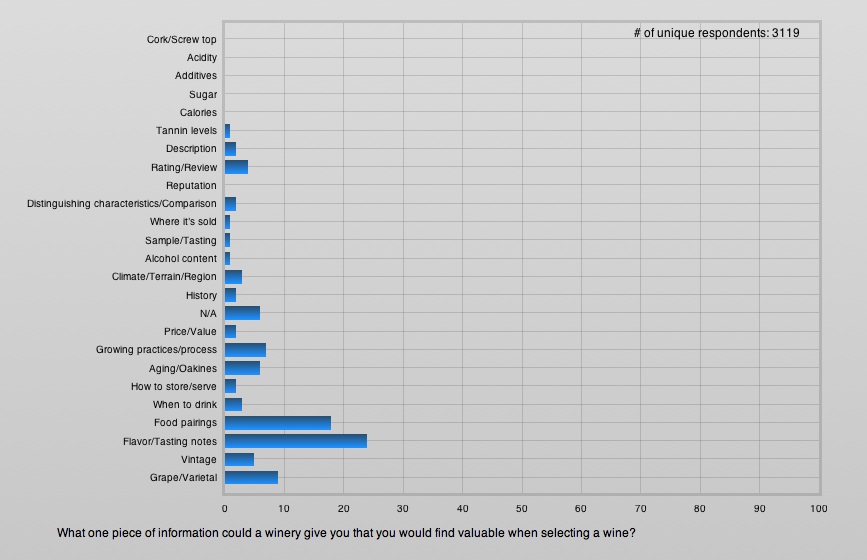Investment management firms always warn that “past performance does not necessarily predict future results.” It makes sense. Just because an investment manager has hit it big in the past doesn’t mean that he or she will know when the next big rise or fall in the market will come.
So why doesn’t that same caveat go with Customer Relationship Management (CRM) systems? Companies spend millions of dollars with companies like Oracle, SAP, Salesforce, Microsoft and many others (and what’s a small to medium size company to do when faced with the investment and difficult implementation?). These systems work off of customer “touchpoints” to make relationships and customer management easier. A “touchpoint” is any past interaction with a customer whether it is a sale where product purchase and customer demographics are acquired, a complaint, inquiry or field contact (assuming the field rep enters the information properly and accurately).
 Have you ever gotten upset that you can’t understand the foreign accented customer center rep when you call to ask a question about your bill? Some of us don’t care but others find it annoying. It’s because the company using the CRM system didn’t note that your call should be routed to a U.S. based call center and decided it’s cheaper to have your call go to someone they’re paying only several dollars a day, customer satisfaction be damned. CRM didn’t help there.
Have you ever gotten upset that you can’t understand the foreign accented customer center rep when you call to ask a question about your bill? Some of us don’t care but others find it annoying. It’s because the company using the CRM system didn’t note that your call should be routed to a U.S. based call center and decided it’s cheaper to have your call go to someone they’re paying only several dollars a day, customer satisfaction be damned. CRM didn’t help there.
Or do you get annoyed when political campaigns send you two or three fund raising requests a day while never asking about your beliefs? They use CRM too but the systems don’t gather your opinions and beliefs. They only note where you live, how you voted last time, whether you gave before and possibly what type of car you drive and magazines you read so they can create a profile they believe is predictive.
How about coming home to find the post office has delivered four L.L.Bean catalogs? Waste of paper? Absolutely, but blame their CRM system for the confusion. Amazon is quite sure that because you bought a book about wine, you’ll absolutely want to purchase a new wine cooler they’re carrying. You may not have even noticed but their CRM system says you’re a prospect. Millions of customers, sales, inquiries, complaints equals billions of data points so inaccurate interpretations, solicitations, mail and email deliveries are bound to happen, right?
Not necessarily. What if something like “forward-looking CRM” were available and affordable? Imagine if companies or politicians asked you what your needs and frustrations are and once they knew, could use that information to tailor responses to you and provide better products, services and build their overall customer relationships. Imagine politicians asking what his or her constituents believe – the massive Town Hall that Ross Perot used to rant about – and adjusting their positions to truly be representative of what voters are telling them. Sound impossible?
It exists
Futureshift’s DirectLink™ system enables you to ask any group what they believe and why, what their needs are and why, and most importantly, what their frustrations are and why. You can ask in an open-ended way questions that begin with “why”, “what” and “tell us about” and people write like they’ve never been asked these questions before. Then, CALCAT™ software takes over and helps tag ideas and beliefs so that qualitative information can be shown quantitatively in bars and graphs just like people are used to.
Below is an example of how DirectLink™ can reveal more about customers. The topic is wine but it could be any product or service. The question in the chart below (“What one piece of information could a winery give you that you would find valuable when selecting a wine?”) was answered by 3,119 people and you can see the array of responses.
But now, let’s say you want to know more. How did people write about some of their answers because you might want to refine the way you give them information. So let’s say you select the response “Flavor/Tasting notes”. You can click that response and then one button, called “Get Verbatims”, which instantly shows a screen like below.
Now, you can read how all of the respondents talked about “Flavor/Tasting notes” and you can see the descriptive language they use or even create word clouds so the most common terms stand out and then you’ll know what the customer’s lexicon is so you can know just what language to use to talk back to them.
 Now, it gets more interesting because you’ll want to talk back to them in a way that is specifically tailored to their needs. This group has indicated that they want better flavor and tasting notes from wine marketers. What if you have something to say to them about this? Is there a way you can reach them immediately? Easy! All you do is click the button at the side that says “Get Emails” and an email list of all the people who are looking for better flavor and tasting notes downloads to your computer, or for that matter, to your mobile device if you’re on the road. Now, you can email them something specific to their needs. This ease in immediate implementation makes it both practical and effective for small businesses to target market.
Now, it gets more interesting because you’ll want to talk back to them in a way that is specifically tailored to their needs. This group has indicated that they want better flavor and tasting notes from wine marketers. What if you have something to say to them about this? Is there a way you can reach them immediately? Easy! All you do is click the button at the side that says “Get Emails” and an email list of all the people who are looking for better flavor and tasting notes downloads to your computer, or for that matter, to your mobile device if you’re on the road. Now, you can email them something specific to their needs. This ease in immediate implementation makes it both practical and effective for small businesses to target market.
It gets better
Typically, with most products, marketers want to get more specific in regards to addressing consumer or customer beliefs. They might have three, four or five variables they want to combine together and this can take days to obtain multi-variable analysis, let alone find the people behind those beliefs. Not any more. Multi-variable analysis and grabbing the people in that specific multi-variable segment is now instantaneous and automatic.
Above, four variables have been selected: (1) women; (2) age 50 – 59; (3) want Flavor/Tasting notes; and (4) prefer to get recommendations from the sommelier. Now, you can look at every question you’ve asked for that group or you can quickly download a list of email addresses for this refined segment so you can send them a message tailored to their needs. The result is a personalized response tailored to your customer’s needs. This creates more customer awareness, interest and loyalty because you’ve shown you’ve listened and are responsive, which is the point of CRM to begin with. Perhaps of more note, however, is how easy it is to operate the system yourself without a bevy of expensive consultants descending to your business and drowning you with minutiae.
Making CRM work better
DirectLink™ can act as a “look-forward CRM” system for small to medium sized companies with databases of several hundred thousand. Groups can be defined by a series of responses to questions and messaging can be tailored to the language they use, beliefs they hold or frustrations they’re holding. In this way, marketing can address the current and future needs of consumers and customers and be truly predictive at a cost that makes it more approachable than those big CRM systems. With larger databases, DirectLink™ information can be appended to databases to make those systems “needs-based” and ultimately more effective.
DirectLink™ and its underlying software platform, CALCAT©, are proprietary products owned by Futureshift, Inc. DirectLink™ is fully functional for both English and Spanish speaking markets. For more information Forward-Looking CRM, write strategy@futureshiftnow.com
Tags: CALCAT©, Consumers, Corporate Myopia, CRM, Customers, Database, Demographics, DirectLink™, Forward-Looking CRM, Future Performance, Investment Managers, L.L.Bean, Marketing, Microsoft, Multi-variable, Multi-variate, Oracle, Past Performance, Relationships, Ross Perot, Salesforce, SAP, Touchpoints














